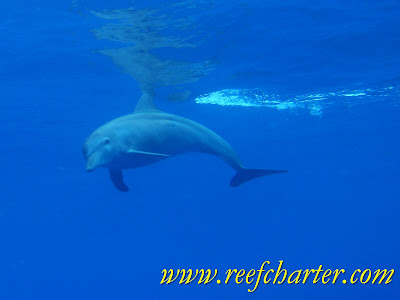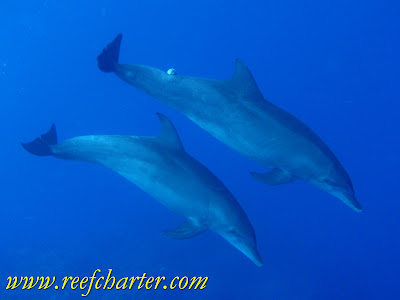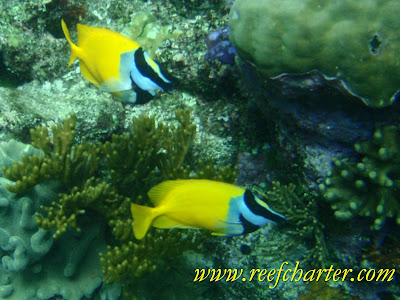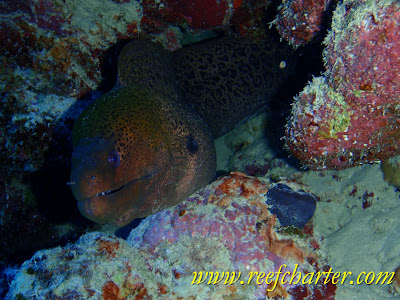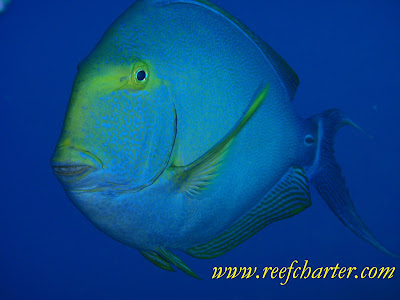Mother nature often gives us some amazing experiences, here two dolphins decided they would like to come and do some diving with us. These two friendly dolphins followed and interacted with our divers and snorkelers for quite a long time. Enjoying the interaction and playing along side our guests and tagging along with our divers. An encounter with a dolphin like this is a fantastic experience and will leave memories that last a lifetime.
Remember, we do not feed or do other activities to attract marine life, so this interaction is completely natural. Making the encounter even more special and truly appreciated. The Great Barrier Reef truly is a natural wonder of diverse and wonderful experiences to be had everyday. If you haven’t been yet you owe it to yourself and family come and experience it. It truly is one of the great wonders of the world and has to be seen to be believed. Yes I love this place! :)
For more photos check out our Tour Photos page or to come and experience the fantastic Great Barrier Reef have a look at our website.
Tag: Species-of-the-Reef
Fox Face or Rabbitfish – Species of the Reef
The foxface or rabittfish was given it’s name from their small, rabbit-like mouths, large dark eyes, and a shy temperament.
The rabbitfish or foxface is an active algae eater on the Great Barrier Reef. They are often seen along with butterfly fish cleaning the coral and reef base. The Foxface grows to about 40cm (16″) long. Their bright and distinct colour bands make them very popular with aquarium owners, they are also relatively easly to keep in aquariums. Often vegetables are added to their diet while they are kept in aquariums.
Rabbitfish also have poisonous spines in their dorsal fins and will use them to protect themselves if they feel threatened. So do not touch or aggrevate these fish. They are also timid fish and will flee if at all possible so this is mainly an issue only in the aquarium environment.
Moray Eels – Species of the Reef
There are over 200 different types of Moray Eels around the world, living in a number of different environments. The smallest moray is about 12cm (5 inches) and the longest is about 4m (13 feet) long. The largest variety of the species being found in warm tropical waters and reefs with diversity lessening as the water becomes cooler.
The Moray Eel relies on camouflage and smell to catch its food as it has relatively poor eyesight. It lies in crevaces and waits for its next meal to swim past. To assist with hiding even the inside of the mouth is coloured to fit in with its surroundings. This also allows the moray to lie in waiting with its mouth open to get little warning to the unsuspecting prey. The moray eel also has a second set of jaws that move forward when attacking and give the eel some extra grip on the prey. This second set of jaws also help pass the food down to the stomach of the ray.
There are only a few predators of the moray eel, they include the barracuda, Groupers, Sea Snakes and other Moray Eels. The Moray itself is carnivorous and eats just about anything.
The Morays have sometimes been described as vicious or ill-tempered, this is not a deserved reputaiton as Morays hide from humans and would rather flee than fight. Morays are shy and secretive, and attack humans only in self-defense or mistaken identity (for example, a finger placed in a crevice where a moray resides may resemble a prey-item). Most attacks involve accidental bites during human-initiated interaction.
Surgeon Fish – Species of the Reef
A colourful and common sight on the Great Barrier reef is the surgeon fish, like the yellow fin surgeon fish pictured above. The distinctive characteristic of the family is the spines, one or more on either side of the tail. Both the dorsal and tail fins are large, extending for most of the length of the body. The small mouths have a single row of teeth used for grazing on algae.
Surgeonfishes sometimes feed by themselves, but they are also often seen traveling and feeding in large colourful schools. It has been suggested that feeding in schools is a mechanism for overwhelming the highly aggressive defense responses of small territorial damselfishes that vigorously guard small patches of algae on coral reefs.
Most species are relatively small and have a maximum length of 15–40 cm (6–16 in), but some members of the genus Acanthurus, some members of the genus Prionurus, and most members of the genus Naso can grow larger, with the whitemargin unicornfish (N. annulatus), the largest species in the family, reaching a length of up to a meter (3,3 ft). These fishes can grow quickly in aquariums so it is advisable to check the average growth size and suitability before adding to a marine aquarium.
